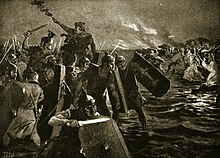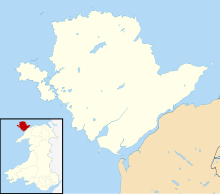
Back Conquista romana de Anglesey Spanish فتح انگلسی از سوی امپراتوری روم Persian Massacro di Menai Italian Bitwa na wyspie Anglesey Polish Conquista romana de Anglesey Portuguese
| Roman conquest of Anglesey | |||||||
|---|---|---|---|---|---|---|---|
| Part of the Roman conquest of Britain | |||||||
 John Harris Valda: The Roman attack on Anglesey (c. 1920s illustration) | |||||||
| |||||||
| Belligerents | |||||||
| Roman Empire | Britons | ||||||
| Commanders and leaders | |||||||
|
Gaius Suetonius Paulinus Agricola | unknown | ||||||
| Strength | |||||||
| unknown | unknown | ||||||
| Casualties and losses | |||||||
| unknown | unknown | ||||||
The Roman conquest of Anglesey refers to two separate invasions of Anglesey in North West Wales that occurred during the early decades of the Roman conquest of Britain in the 1st century CE.[1] The first invasion of North Wales began after the Romans had subjugated much of southern Britain. It was led by the Provincial governor of Britannia, Suetonius Paulinus, who led a successful assault on the island in 60–61 CE, but had to withdraw because of the Boudican revolt.[2] In 77 CE, Gnaeus Julius Agricola's thorough subjugation of the island left it under Roman rule until the end of Roman rule in Britain in the early 5th century CE. The invasions occurred because Anglesey, which was recorded in Latin as Mona (and is still known as Môn in modern Welsh) was a place of resistance to Roman rule because it was an important centre for the Celtic Druids and their religious practices.[3]
No surviving Roman sources mention Anglesey after the conquest. Archaeologists have located a fort dated shortly after the first conquest near Cemlyn Bay; a trading settlement on the shore of the Menai Strait; and a village of huts huddled together on a hill for defence. In the last decades of Roman rule in Britain several military forts were built on the northern and western coasts to defend the island against Irish sea raiders.[4] However, despite more than three centuries of Roman rule, archaeologists have found no evidence of major civic centres or villas on the island indicating that Romano-British culture lacked the influence it had in other parts of the Roman province of Britannia.
The only Roman source for the island's two invasions is the Roman historian Tacitus. His last work The Annals, written as a history of the Roman Empire from Tiberius until Nero, mentions the first invasion by Suetonius Paulinus.[5] The second invasion is detailed in Tacitus' work The Life of Gnaeus Julius Agricola, which was written to record and extol the life and accomplishments of his father-in-law.[5] Tacitus may have used first-hand accounts from Agricola, who had been present with the Roman forces on both occasions.

- ^ Malcolm, Todd (2004). A companion to Roman Britain. London: Historical Association. pp. 60–74. ISBN 1-4051-2893-3. OCLC 55880775.
- ^ "Cornelius Tacitus, The Annals, BOOK XIV, chapter 31". www.perseus.tufts.edu. Retrieved 19 August 2022.
- ^ Rogers, Adam C. (2008). "Religious place and its interaction with urbanization in the Roman era". Journal of Social Archaeology. 8 (1): 37–62. doi:10.1177/1469605307086077. ISSN 1469-6053. S2CID 143531270.
- ^ Hopewell, David (5 June 2018). "Roman Anglesey: Recent Discoveries". Britannia. 49: 313–322. doi:10.1017/s0068113x18000247. ISSN 0068-113X. S2CID 165955694.
- ^ a b "Cornelius Tacitus, The Annals". www.perseus.tufts.edu. Retrieved 5 April 2021.